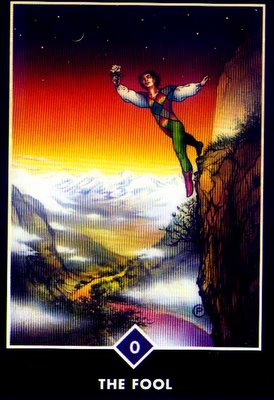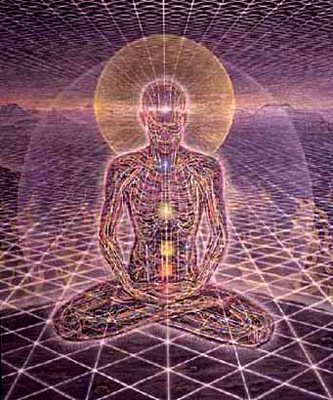 [Please see the Introduction to this series for a brief synopsis of my approach to working with the major trumps of the Tarot. I am hoping to post a new meditation each Saturday. I use meditation here in the philosophical sense of the word, meant to denote an open-ended, free-form exploration of an idea.]
[Please see the Introduction to this series for a brief synopsis of my approach to working with the major trumps of the Tarot. I am hoping to post a new meditation each Saturday. I use meditation here in the philosophical sense of the word, meant to denote an open-ended, free-form exploration of an idea.]We begin our journey with the Fool, a person often depicted with a small dog--usually nipping at her/his heels or coat tails. [I am choosing here to leave the Fool ungendered as an archetype for many reasons, not least of which is that the Fool represents the soul being reborn into samsara.] Traditional readings suggest that the dog serves as a warning of impending danger, that the Fool’s blind wanderings (s/he is sometimes depicted with a blindfold) might lead to self-destruction. (The Rider-Waite deck shows the Fool at the edge of a cliff, about to step off, with the dog barking at his heels.) To me, this is a misreading of the Fool archetype, as I will explain below.
The Fool is the only unnumbered card in the Tarot (most modern decks mistakenly assign it the zero designation). As such, it stands as the unconscious, newly manifest soul returning for another journey through life. At this point the soul is naïve, pre-egoic, and essentially unconscious, but it comes into the world "trailing clouds of glory":
Our birth is but a sleep and a forgetting:
The Soul that rises with us, our life's Star,
Hath had elsewhere its setting,
And cometh from afar:
Not in entire forgetfulness,
And not in utter nakedness,
But trailing clouds of glory do we come
From God, who is our home:
Heaven lies about us in our infancy!
(William Wordsworth, Ode 536)
Ken Wilber references this poem in talking about infant spirituality. According to Wilber,
The "trailing clouds of glory" refers in general to all the deeper psychic (or soul) awareness that the individual brings to this life and which is therefore present in some sense from conception forward (however you wish to construe that--as reincarnation, or simply as deeper potentials present from the start).
(Integral Psychology, 141)
The Fool comes into the world with a certain degree of wisdom and awareness that most of us lose as egoic consciousness develops. This is the origin of the "wise fool" idea that appears so often in drama and literature. Yet, lacking self-awareness, the Fool's wisdom often manifests in peculiar ways, which is why it belongs to the tradition of the Trickster.
The energy of the Fool, in its most focused form, is the energy of life--primitive, raw, undefined. Its manifestation within each of the other archetypes of the Tarot deck vitalizes those archetypes and animates them. S/he is the catalyst for the evolutionary process of moving through self-actualization, which is why s/he is unnumbered and stands outside the linear development of the major arcana. S/he is both the beginning of the process and its end.
However, s/he evolves as s/he moves through the archetypes represented by the other cards. If the Fool comes into the world as naïve and pre-egoic, s/he leaves the world wise and post-egoic. Rather than the neo-Jungian conception of the "ground of being" (a view that says "the pre-personal and transpersonal share with each other the experience of the dynamic, collective, spiritual ground of existence")--a concept that denies a hierarchy of consciousness development (see this interview with Michael Washburn)--the Tarot suggests that consciousness does develop through stages roughly equivalent to the Great Chain of Being.
 In the Osho Zen version of the Fool, most of the traditonal imagery is stripped away and we are left with a Fool who looks similar to the fool of Shakespearean tradition. The Osho Zen interpretation of the card is somewhat simplistic, but it attempts to get at some of the central magic of the Fool.
In the Osho Zen version of the Fool, most of the traditonal imagery is stripped away and we are left with a Fool who looks similar to the fool of Shakespearean tradition. The Osho Zen interpretation of the card is somewhat simplistic, but it attempts to get at some of the central magic of the Fool.What makes the Fool a powerful archetype when it manifests is that s/he lives solely in the present. S/he cannot consider consequences and has no memory of past choices or outcomes. Every instant is new, which allows for a pure form of trust that can be betrayed by more egoic people.
The instinctual/intuitive Fool pushes forward where the rational mind hesitates. This is both a strength and a source of trouble, but it can be no other way. The Fool’s spontaneous approach to life can appear as wisdom, madness, or folly, depending on who is observing. When that spontaneity is in tune with the individual's path, miracles can occur--when it is out of synch with the person's path, chaos is unleashed. For these reasons, working with Fool energy can be risky.
The Fool card is almost always best understood in relation to another card or cards. This is because the Fool encompasses all the energetic polarities and can manifest within any of the archetypes, which makes it difficult to pin him/her down as one thing or another. Just when we think we understand, s/he is something else and is laughing at us.
The opposite problem for those manifesting Fool energy is that they rarely know who they are, and they are unconscious of the processes working through them, which leaves them without a sense of direction or a clear sense of identity. As a result, all forms of negative energies can invade the psyche, leading to "acting out" and other "foolish" behaviors.
 As an aside, it's interesting to me that Fool energy in men often takes on a feminine quality, while in women it takes on a masculine quality. This curious manifestation seems, to me, to indicate that the Fool archetype is connected to our contra-sexual archetype and is a shadow aspect for most of us--or as Marie Louise von Franz suggests, the Fool is connected to the inferior function, the place where we feel foolish. A well-integrated psyche is not likely to experience the Fool in any unconscious way.
As an aside, it's interesting to me that Fool energy in men often takes on a feminine quality, while in women it takes on a masculine quality. This curious manifestation seems, to me, to indicate that the Fool archetype is connected to our contra-sexual archetype and is a shadow aspect for most of us--or as Marie Louise von Franz suggests, the Fool is connected to the inferior function, the place where we feel foolish. A well-integrated psyche is not likely to experience the Fool in any unconscious way.Realizing one is working with the Fool is equivalent to receiving "the call" to begin the path of individuation. Out of the Fool-Trickster figure develops the figure of the Hero-Savior (the Hero always receives a calling)--but only if the call is obeyed. If so, one experiences the evolutionary movement from pre-personal to personal to trans-personal.
A necessary concomitant to this transformation is that the Fool must endure the suffering sometimes created by his/her unconsciousness. Because of this, the Fool-Trickster provides the strongest resistance to initiation (heeding the call) into the life of soul-consciousness. However, if one fights the process, the resistance can erupt in a variety of self-destructive ways, including drug/alcohol abuse, physical violence against others, physical violence against oneself, or any number of other forms of “acting out.”
This need not be so. If one surrenders to the energy of the Fool when the archetype becomes present in one’s life, it is then possible to begin the process of moving forward on the path of individuation. Along this line of thinking, the Fool most often appears during times of psychological/spiritual crisis. When one is in the abyss, the Fool’s life-energy can guide one out, and into the full experience of life. Thus, the Fool is a call to action (beginning the process of self-growth) and a call to surrender (allowing the life-energy to move us in the direction that will allow us to become whole).





